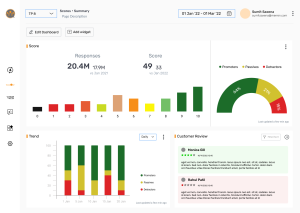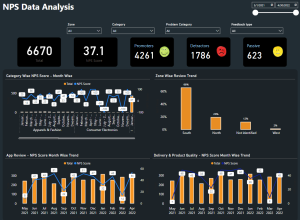Customer feedback is the cornerstone of any successful business strategy, especially in the B2B industry. One of the most efficient ways to gather this feedback is through in-app surveys. This short guide will delve into the essentials of in-app surveys, tailored specifically for Customer Experience (CX) professionals.Now effectively gather customer feedback using in-app surveys and enhancing your customer satisfaction and business outcomes.
What Are In-App Surveys?
In-app surveys are questionnaires embedded directly within a mobile or web application. In this manner, users can provide feedback without leaving the app environment. These surveys can be presented in various forms, such as pop-ups, embedded forms, or full-screen takeovers. The primary advantage is their ability to capture user feedback in real-time, after a transaction or post-purchase.
In-app surveys are inmoment in nature. It can serve multiple purposes:
- Understanding User Satisfaction: Gauge how satisfied users are with your app or service.
- Identifying Pain Points: Discover issues users face while using your app.
- Gathering Feature Requests: Learn what new features users would like to see.
- Improving User Experience: Use feedback to enhance the overall user experience.
Why Are The Benefits Of Using In-App Surveys?
In-app surveys can gauge customer experience in real time. In-application surveys are a must-have CX tool to bring constant feedback on app performance, app usage, user interface and other minute details. Here are some of the benefits.
Instant user feedback:
In-app surveys provide the opportunity to collect feedback at the moment users are engaging with your app. This immediacy means the feedback is fresh and directly related to the user’s recent experience, making it more reliable and actionable.
Higher response rates:
Since in-app surveys are integrated into the app experience, users are more likely to participate. Unlike email surveys or external links, in-app surveys require minimal effort from the user during sharing feedback.This brings a higher response rate.
In-the-moment survey relevance:
In-app surveys can be triggered by specific user actions or behaviors. This means that the feedback collected is relevant to the user’s experience in-the-moment. For example, after a user completes a purchase or uses a new feature, a survey can be triggered to gather their immediate feedback.
Enhanced user engagement:
By asking for feedback directly within the app, you show users that their opinions are valued. This engagement can lead to increased user loyalty and satisfaction, as users feel more connected to your brand.
5 Types of In-App Surveys
1. Pop-Up Surveys
Pop-up surveys appear as small windows that overlay the current app screen. These are usually brief, consisting of one or two questions. These surveys are triggered by specific user actions, such as completing a transaction or after a certain amount of app usage.
2. Embedded Surveys
Embedded surveys are placed within the app interface itself, such as in the settings menu or after completing a specific task. These surveys are less intrusive than pop-ups and allow users to complete them at their convenience.

3. Full-Screen Surveys
Full-screen surveys take over the entire app screen and are typically used for more comprehensive feedback collection. These surveys are suitable for gathering detailed information. However, it should be used sparingly to avoid disrupting the user experience.

4. NPS (Net Promoter Score) Surveys
NPS surveys measure user loyalty by asking a single question: “How likely are you to recommend this app to a friend or colleague?” Users respond on a scale from 0 to 10. Their responses are used to calculate the Net Promoter Score. Based on the number of detractors to promoters, the score is a key indicator of customer loyalty.
5. Exit Surveys
Exit surveys are triggered when a user is about to leave the app. These surveys aim to understand why the user is leaving and gather feedback that can help improve retention.
Designing Effective In-App Surveys: Best Practices
In-application surveys need to be goal oriented as per the action of the user. Trigger appropriate feedback forms based on the user activity. Here are some of the best practices a CX professional can adopt for a high response rate.
Keep it short and simple
The key to high response rates is brevity. Focus on asking a few important questions that can provide the most valuable insights. A survey with too many questions can lead to survey fatigue, where users abandon the questionnaire before completing it.
Use clear and concise language
Ensure that your questions are easy to understand and answer. Avoid jargon or complex language that might confuse users. Clear and straightforward questions will yield more accurate responses.
Offer survey rewards
Incentives can significantly boost response rates. Consider offering small rewards, such as discounts, loyalty points, or entry into a prize draw, to encourage a high survey completion rate. You can learn how to create Merren survey rewards in this blog.
Personalize the experience
Personalization can make the survey experience more engaging. Use the data you have about the user to tailor questions that are relevant to their specific interactions with the app. For example, if a user frequently uses a particular feature, ask questions about their experience with that feature.
Timing is key
The timing of your survey can greatly impact response rates and the quality of feedback. Avoid interrupting users during critical tasks. Instead, trigger surveys at natural breakpoints, for example, after completing a transaction or when they navigate to a new section of the app.
The Right Way to Implement In-App Surveys
Identify Key Touchpoints
Determine the key moments in the user journey where feedback is most valuable. These touchpoints might include after a user completes a purchase, finishes using a feature, or experiences an error. Mapping out these touchpoints will help you strategically place your surveys for maximum impact.
Choose the Right Survey Tool
Selecting the right survey tool is crucial for seamless implementation. Look for a tool that integrates easily with your app and offers robust features such as conditional logic, customizable templates, and advanced analytics. Merren provides comprehensive survey solutions designed for non-technical users, making it easy to set up and manage in-app surveys.
Test Before Launch
Before deploying your surveys to all users, conduct thorough testing to ensure they function correctly. Check for any technical issues that might disrupt the user experience. Ensure that the survey triggers at the appropriate moments. Gathering feedback from a small group of users during the testing phase can help you make necessary adjustments.
Monitor Performance
Once your surveys are live, continuously monitor their performance. Track response rates, completion rates, and any technical issues. This ongoing monitoring will help you quickly identify and address any problems, ensuring a smooth user experience.

The Right Way of Collecting Feedback: Best Practices
Be timely
Timeliness is crucial for collecting accurate feedback. Surveys should be triggered immediately after a relevant user action to capture their thoughts while the experience is still fresh in their minds. For example, if a user completes a purchase, trigger the survey right after the transaction is confirmed.
Use conditional logic
Conditional logic allows you to show or hide questions based on previous responses. This personalization can make the survey experience more relevant to the user and help you gather more detailed insights. For example, if a user indicates dissatisfaction with a feature, follow up with questions to understand the specific issues they faced.
Maintain user privacy
Respecting user privacy is paramount. Ensure that your surveys comply with privacy regulations such as GDPR or CCPA. Clearly communicate to users how their data will be used and ensure that it is stored securely. Providing an option for users to opt-out of surveys can also help build trust.
Monitor and iterate
Collecting feedback is an ongoing process. Regularly review the data you collect and use it to make informed decisions. Don’t be afraid to iterate on your survey design and implementation based on user feedback and changing business needs. Continuous improvement will help you gather more valuable insights over time.
3 Ways to Analyze Customer Feedback Data
Identify common market trends:
Aggregate the responses to identify common trends and insights. Look for patterns in the data that can help you understand overall user sentiment and common pain points. Merren CX can provide robust analytics features that make it easy to aggregate and visualize survey data.
Segment responses based on filters:
Segmenting responses by different user groups can provide deeper insights. For example, you might segment data by user demographics, usage frequency, or subscription level. This segmentation can help you understand how different user groups experience your app and identify specific needs and preferences.
Close feedback loop to improve CX:
The ultimate goal of collecting feedback is to take action based on the customer feedback insights. Use the feedback to make data-driven decisions that improve the user experience. Whether it’s fixing a bug, adding a new feature, or enhancing customer support, acting on feedback shows users that their opinions are valued. This leads to a better overall app experience.
Get Responsive In-App Surveys with Merren CX Dashboard
Comprehensive CX solutions
Merren provides end-to-end solutions for creating, deploying, and analyzing in-app surveys. Whether you need a simple pop-up survey or a comprehensive full-screen questionnaire, Merren’s platform offers the tools you need to design effective surveys tailored to your specific requirements.
User-friendly interface
Designed for non-technical users, Merren’s interface is intuitive and easy to navigate. Setting up and managing surveys requires no technical expertise. CX professionals can focus on gathering and analyzing feedback without worrying about technical complexities.

Dashboard analytics
Merren’s analytics tools help you gain deep insights from survey data. With features like real-time reporting, response segmentation, and trend analysis, you can make data-driven decisions that drive customer satisfaction and business growth.
Conclusion
In-app surveys are a powerful tool for CX professionals to gather real-time, relevant feedback from users. By following best practices and leveraging tools like Merren, you can enhance customer satisfaction and drive business growth. In-app surveys provide immediate, contextual, and actionable insights that can help you improve your app and better meet the needs of your users.
For more information and to get started with in-app surveys, sign up for a 14 day free trial here. Implementing in-app surveys with Merren will empower you to collect valuable feedback, make data-driven decisions, and ultimately enhance your customer experience.

